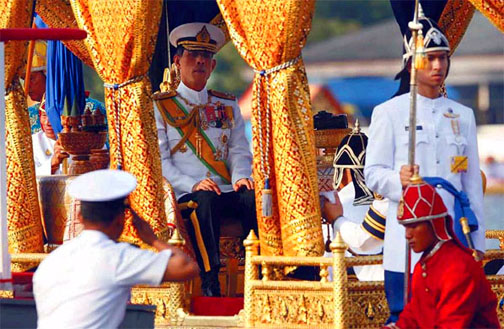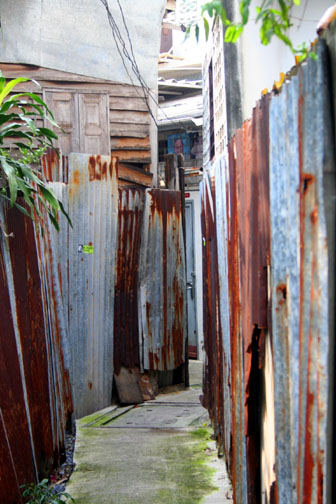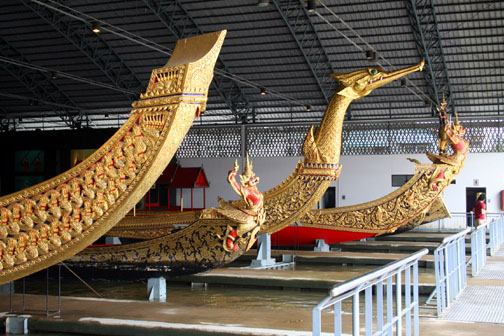Tags

HRH Crown Prince Maha Vajiralongkorn on the barge Subanahongsa during the Royal Barge Procession in 2007.
This year The River of Kings will play host to an extragavansa infrequently seen in this day. On October 22, with much pomp and circumstance, a Royal Barge Procession will be held along the Chao Phraya River in Bangkok. Dress rehearsals of this momentous event are scheduled for the 13th and 18th of October.
The Royal Barge Procession, part of the Royal Kathin Ceremony, is only held to celebrate the most important religious, royal, or cultural occasions. An ancient tradition that was revived by His Majesty King Bhumibol in 1959, the parade of stunningly ornate barges has sailed only sixteen times during his reign; the last procession was in November 2007 in honor of his 80th birthday.
This year’s breathtaking waterborne display, according to Rear Admiral Apiwat Sriwattana, will be held to commemorate the auspicious occasion of HM King Bhumibol’s 84th birthday on 5 December 2011. The procession marks the visit of members of the royal family to Wat Arun, a royal temple, to present offerings of saffron kathin robes, food and other necessities, to the monks to mark Awk Phansa, the end of the three-month Buddhist rains’ retreat.
Officially known as the Praratcha Phithi Phra Yuha Yatra Cholamak (Royal Waterway Procession), the waterborne procession comprises a flotilla of 52 traditional-style barges, including the four major royal barges. This procession, the Major Battle Formation (Petch Phuang Formation) dating from the time of King Narai, has the barges arranged in five columns, with the Royal Barges in the center and two rows of war barges on each side. The mile long flotilla which begins at the Wasukri Royal Port, stretches along the Chao Phraya River, and starts with the trumpeting of conch shells and the beating of chana and mahorathuk drums that begin the royal anthem.
His Royal Highness Crown Prince Maha Vajiralongkorn will preside over the event and will represent His Majesty the King during the Royal Kathin ceremony at Wat Arun. Prince Vajiralongkorn will board the royal barge Subanahongsa at Vasukri Pier at 3.30 pm and should reach Wat Arun at about 4:15 pm.
Subanahongsa is the main royal barge and is named after the swan-like mythical steed of Brahma, the Golden Hamsa. King Rama I had the original barge built soon after his accession to the throne in 1782. The boat was in constant use as the Principal Royal Barge until she became too old to be repaired. King Rama VI then commanded the building of her successor, the present Subanahongsa which was launched on November 13, 1911. Most of the barges were damaged or destroyed during WWII and rebuilt or reconditioned by order of HM King Bhumibol.
Subanahongsa is made out of a single trunk of teakwood and measures just over 150 feet in length. She carries 50 oarsmen, 2 steersmen, 2 officers fore and aft, 1 standard bearer, 1 signalman, I chanter and 7 Royal Insignia bearers, and a spired throne or a roofed pavilion surrounded by court officials is displayed on her deck.
The most majestic of all Royal Barges, the story is told that the master craftsman who built the Subanahongsa threw away all his tools after her completion and vowed never to work again. The barge’s masthead holds a crystalline ball and tassel in her mouth. Her feathers, made of gilded and mirrored ornaments, flow in the wind along the length of her body, ending at her flame-like tail. In motion on the water the golden hamsa is presented in full flight powered by the oarsmen’s rhythmic motion; her paddles flashing in the sunlight suggests the graceful movement of her wings.
The royal barges of Thailand are the last of their kind in the world. Each is carved from huge pieces of teak with prows carved into mythical creatures, gilded in gold and intricately decorated with tiny shimmering pieces of glass. A total of 2,200 sailors from various units within the Royal Thai Navy will serve as oarsmen during October’s procession.

The Narai Song Suban Royal Barge was built and presented to HM King Bhumibol during the celebrations marking the Fiftieth Anniversary of His Majesty’s Accession to the Throne in 1996.
Royal barge processions take approximately 55 minutes to make the 3 mile journey down the Chao Phraya River from the Wasukri Royal Landing Place in Khet Dusit to Wat Arun. The official ceremony is expected to end at approximately 5.30 pm. Santi Chai Prakarn Park on Phra Arthit Road is one of the more popular viewing spots and is usually packed with thousands of onlookers.
The Royal Barge Procession to be held this October is an infrequent opportunity for visitors to see these magnificent boast under sail. Usually, touri can only see them docked at the Royal Barge Museum, where eight important barges – including all four Royal Barges – are tucked away just inside a canal across the river from the Grand Palace. In addition to the barges, around the interior perimeter of the Royal Sheds are storyboards explaining the historical use of the barges, along with display cases of photographs as well as oars, flags and other paraphernalia of the procession ceremonies.
Each of the majestic barges are hand crafted, intricately carved, colorfully painted, and inlaid with hundreds of tiny mirrors and glass shards to make each barge shimmer and sparkle during both the day and night. Every Royal Barge is headed by a mythical figure or creature and is ornately decorated.
Most touri visit the Royal Sheds by taking the Chao Phraya Tourist Boat which stops right at the museum. If you take the regular Express Boat service, the nearest stop is Pinklao Bridge Pier. Another option is a nice, long, winding walk through an interesting neighborhood of local houses that begins just across the bridge on Arun Amarin Road near Khaosan Road.
Right after the stairs for the bridge end, on the right hand side of the road, a small sign marks the entrance to roughly 300 yard path that leads to the museum. You may think you are lost as you wind your way down the narrow walk which is often lined by rusting, corrugated tin walls, but just keep an eye out for the occasional small sign posted to lead you to the museum.

The narrow, winding path leading to the Royal Barge Museum looks like you may have taken a wrong turn somewhere.
Admission to the museum is 30 Baht per person. If you want to take pictures, there’s an additional fee of 100 Baht . The museum is open 9:00 a.m. to 5:00 p.m. every day but is closed on New Year’s Eve day, New Year’s Day, and during the Songkran period.



took me about 3 tries before I finally got a chance visit the museum when it was open as the first time it was closed due to high water and the second time it was closed because they were restoring the barges. It is a very interesting place that doesn’t get very many visitors. We drove there and did the long walk you describe. My guide demonstrated the songs/chants for me which was a nice touch.
“My guide demonstrated the songs/chants for me ”
Nice!
My friend Noom took me without telling me where we were going. His older brother lives along that pathway and hangs out at the museum. When we got there, it was closed, too. But his bro ran back to one of his mate’s house and got the keys. But no one offered to chant for me!
🙂
I’m jazzed that the procession will happen while I’m in town, really looking forward to that.
yeah, he’s a super nice guy who has his own freelance guide business. I think of him more as a friend than as a guide. We’ve taken some really nice trips. Headed to Khao Yai Nat’l Park for a few days on this year’s trip.
I’ve seen some beautiful pix from Khao Yai, but haven’t managed to make that trip yet. Sounds like a wonderful time you’ll be having Glenn.